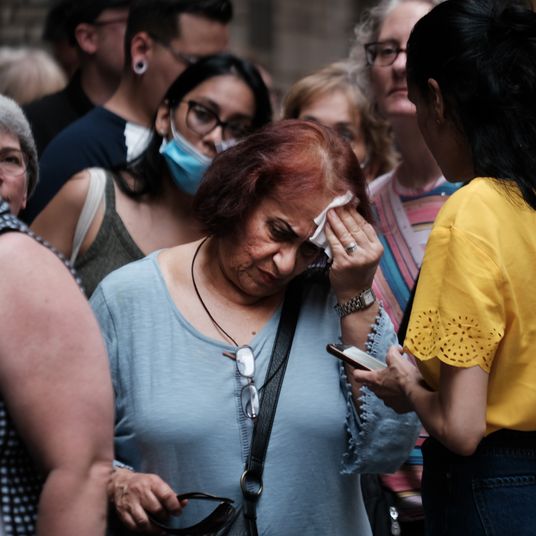
As we approach the second anniversary of the shocking landmark Supreme Court decision in Dobbs v. Jackson Women’s Health Organization, which swept away any federal constitutional right to abortion, there’s a growing sense among abortion-rights activists that any future template for protecting reproductive rights will need to go well beyond Roe v. Wade. While Roe (and its successor case Planned Parenthood v. Casey) protected women from state laws prohibiting abortion, there were obviously some shortcomings in the rules established by the Supreme Court decision that could theoretically be addressed in the future. Unfortunately, it’s unclear if and when a stronger (and more durable) set of protections will become possible in this country.
For all of its 48 years as the law of the land, Roe drew friendly fire from abortion-rights advocates who lamented its scope and vulnerability. To begin with, Roe’s foundation in constitutional law was always controversial. It rested on a non-enumerated right to privacy in the Due Process Clause of the 14th Amendment and a particularly shaky set of precedents, notably Justice William O. Douglas’s 1965 opinion in Griswold v. Connecticut striking down state contraception bans. No less a feminist than Justice Ruth Bader Ginsburg famously frowned on Roe’s constitutional reasoning and argued that the Equal Protection Clause and a right to gender equality would have been sounder.
Roe also established an awkward trimester framework for state abortion restrictions, forbidding them in the first third of pregnancy; allowing health regulations in the second; and permitting total bans with life-and-health exceptions in the third. This was always confusing and counterintuitive, and while the simpler fetal-viability red line created by the Casey decision in 1992 solved that problem, Casey substituted an “undue burden” test for pre-viability abortion restrictions that let states constantly experiment with hostile regulations and discourage abortion providers. Either way, abortion care was treated more as a contingent privilege than as a personal right.
As my colleague Irin Carmon pointed out after Roe was reversed and Republicans began talking about finding a “compromise” policy, Roe (and even more obviously Casey with its slippery “undue burden” standard) itself represented a compromise between the idea of a woman’s rights and the state’s “interest” in fetal life, creating judicial balancing tests that varied by court or jurisdiction. This scheme, says abortion rights advocate Erika Christensen, “accepts the premise that there’s a reasonable point in pregnancy in which the state should be given authority to compel breeding.” Debating where that point falls gives away a lot of ground to the anti-abortion movement.
Beyond its questionable treatment of abortion as something less than a right, Roe also failed to make abortion services actually available on anything like an equal basis. Three years after Roe was handed down, Congress enacted the Hyde Amendment, banning the use of federal funds to pay for abortions in all but an extremely limited number of cases. After an extended battle through the federal judicial system, a 5–4 majority of the Supreme Court in Harris v. McRae upheld the constitutionality of the Hyde Amendment, which has been subsequently renewed (with minor adjustments in scope) by Congress in appropriations measures ever since. When combined with the limited reach of abortion providers, particularly in the conservative states that constantly did battle with them, the Hyde Amendment meant that during the Roe era the “right to choose” was at best theoretical for millions of women, particularly women of color and people from disadvantaged backgrounds.
Still another charge against the Roe regime that became especially widespread after it collapsed is that it instilled a sort of complacency among pro-choice Americans and particularly in the Democratic Party, which had gradually become a pro-choice party facing an increasingly militant anti-abortion GOP. Certainly, any complacency was ill-founded, particularly after the big scare in 1992, when a Supreme Court that seemed poised to reverse Roe instead confirmed it thanks to a last-minute coalition put together by Reagan-appointed Justices Sandra Day O’Conner and Anthony Kennedy. More appropriately, you could argue that dependence on the Supreme Court for any sort of abortion rights made the battle remote and inscrutable to voters for whom constitutional law is a foreign language and the process for choosing and confirming Supreme Court justices is as obscure as Hammurabi’s Code.
So now that Roe is gone, should it also be forgotten? Should its abortion protections with all their limitations be placed on the ash heap of history in favor of something more satisfyingly sweeping and principled? And can we look forward with confidence to a day when safe and affordable abortion services are available from sea to shining sea?
Unfortunately, that’s not likely in the cards in the immediate future.
Rebuilding a Supreme Court majority that favors restoring any sort of federal constitutional right to abortion will likely take many years, and if the goal is a more comprehensive guarantee than Roe provided, the wait could be perpetual. The very best-case scenario in the courts is a reversal of Dobbs as a historic aberration that violated the doctrine of stare decisis and a return to Roe and Casey.
A more direct path to federal abortion rights is through Congress and a law that preempts state abortion restrictions. The preeminent model for such legislation is the Women’s Health Protection Act, which passed the House on a near-party-line vote in September of 2021 but was killed by a Senate filibuster in February 2022. The WHPA (unlike the marginally bipartisan Reproductive Freedom for All Act, which seeks to turn back the clock to the day before Dobbs) improves on the Roe regime by clearing away the sneaky and troublesome state restrictions allowed by the Supreme Court after Casey. But it retains the fetal-viability standard and doesn’t ensure public funding of abortion services. More importantly, enacting it would require a Democratic trifecta in Washington and then either a supermajority in the Senate or a Democratic majority willing to abolish or significantly modify the filibuster. None of these ingredients will necessarily be in place in the near future, and even if they were, a Republican trifecta in Washington could reverse it entirely (particularly if Democrats first took care of the filibuster).
While a restored federal constitutional right to abortion seems unlikely in the near term, it’s a different matter at the state level. Courts in nine states have recognized some sort of Roe-style (or in some cases less sweeping than Roe) right to an abortion in state constitutional provisions protecting privacy or bodily autonomy. Voters in the pro-abortion-rights bastions of California and Vermont have approved constitutional amendments with broader provisions than Roe, discarding, for example, the viability standard; voters in Michigan approved an amendment modeled on Roe. State constitutional amendments via citizen initiatives are working their way toward the ballot box in multiple states this year, though most are shaped after Roe. Many abortion-rights advocates are unhappy with Roe-style amendments for all the reasons discussed above, but politically it’s clear that Roe is familiar to voters in a way that more thoroughgoing guarantees simply aren’t.
While pro-choice ballot initiatives are undefeated since Dobbs, sooner or later they will hit the wall in more conservative states. And that will leave a situation where in significant portions of the country there is little or no meaningful access to abortion at all. Right now, all or virtually all abortions are banned in 14 states. There’s a shred of federally guaranteed access to abortion in emergency medical situations, but the U.S. Supreme Court could kill that any day now. And another way around state bans via mail-order abortion pills is under attack at the Supreme Court as well and would definitely be closed off in part or in whole if Donald Trump returns to the White House. Over time, there’s a real chance that a sense of complacency far worse than that induced by Roe will fall over blue states where abortion remains available, while women in red states are left to the harsh ministrations of Republican governors and legislators.
While bringing back Roe in its full federal constitutional splendor is unlikely any time soon, its benefits should not be gainsaid, nor its value as a model for congressional or state action dismissed out of hand. For 48 years, there was no place in America like Texas, Georgia, Florida, Alabama, or Tennessee today, where women must resort to illegal abortions or flee their home state for medical treatment. Right now, there is a national majority outraged by the reversal of Roe and prepared to support its restoration at either the federal or the state level. And for all its limitations, a right to pre-viability abortions (with exceptions for the life and health of the woman involved) covers an estimated 99 percent of abortions, which may not be as philosophically or morally satisfying as an absolute right but is close to it in practice. Restoring Roe in some form is probably going to be the best and only way to protect abortion rights in America across geographical and even party lines. So the hoary precedent deserves some respect.
More on life after roe
- Southern Baptists’ Attack on IVF Will Likely Backfire
- The Supreme Court Didn’t Crush Abortion Rights for Once
- Abortion Rights Look Set to Sweep Again on November Ballot






























